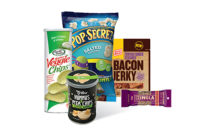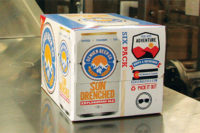By now you have noticed what appears to be a rise in power of pouches for use in the food and beverage segment. Aisles upon aisles of retail stores are making room for flexible packaging solutions for products like sauces, baby food, soup and even beverages. It’s no wonder this trend is catching on and taking over the aisles. Pouches tout environmental benefits: lighter weight, ease of use, resealability and convenience. They also pose significant benefits when compared to rigid packaging materials.
“Flexible packaging offers significant operational efficiency and productivity benefits to food and beverage processors compared to rigid alternatives. The reduced size and weight of flexible packages makes them simpler and more economical to transport. For some products, this can mean the difference in fitting an extra pallet onto a truck, lowering transportation and fuel costs rigid packages may incur, says Myra Foster, executive director, global fluids sector, Sealed Air’s Cryovac® food packaging brand (cryovac.com).
In addition to shipping savings, pouches save on waste too.
From a sustainability standpoint, bags and pouches represent less waste entering the solid waste stream and take up less room in landfills in areas where recycling isn’t available, says Art Malcomson, director of sales & marketing at Zip-Pak (zippak.com), an ITW company.
The perks are evident for manufacturers, but also for consumers and users alike.
“The benefits of flexible packaging extend to end-users as well. Bag and pouch packages are typically easier to open and discard than traditional rigid containers. These lighter packages are also safer for consumers than heavier alternatives – a bag or pouch dropped on a foot will likely cause less harm than a can or pail. In addition, rigid packaging often requires an opener to access the product and can potentially form sharp, jagged edges,” continues Foster.
Spouted convenience
Single-serve is a hot trend right now and many pouches are popping up to offer that serving for one convenience. Hoffer Plastics Corp. (hofferplastics.com) introduces the Trust-T-Lok™ spout designed specifically for flexible, single serve pouches. Trust-T-Lok was engineered and tested for more than a year and resulted in this creative “T”-shaped cap for flexible package spouts that meets all CPSC choke-proof specifications.
Dole Squish’ems apple sauce pouch line is using the new cap, which provides superior tamper evidence and easy-grip shape and texture, and is designed and tested for toddler safety.
The Trust-T-Lok provides a unique plug seal that maintains seal integrity for one full rotation of the cap. The cap reveals superior tamper evidence at one-quarter of a turn of the cap, and remains sealed even at three-quarters of a turn. In addition to providing safety, it means that shelf-life is not compromised if the cap is accidently turned slightly.
If its baby and toddler food you are looking for, consider a new pouch that you won’t find on store shelves, but is lining pantries nonetheless. Squeez’Ems, from Booginhead (booginhead.com), are eco-friendly, reusable food pouches for any pureed or blended food. Designed for parents who make their own baby food or just want to fill the pouch from bulk applesauce or yogurt, Squeez’Ems are easy to fill, clean and store for on-the-go families.
The pouches are made of high and low density polyethylene and are BPA, PVC and Phthalate free. They are an earth-friendly choice because they are refillable and reusable. Squeez’Ems are comprised of just one piece to eliminate the worry over losing parts and the new screw top lid turns clockwise to prevent accidental opening. The pouches have an open window so there’s no guessing what’s inside and they have a 100% leak-proof seal.
| Stick pouches gain traction |
| We’ve all seen them by now- the stick pouch. Items like drinkable yogurt and powdered drink mixes in individual serving flexible stick pouches. They are creeping onto store shelves as a new pouch meant for a specific purpose. And while they have their niche areas, the market for these flexible sticks is growing. According to Allied Development Corp. (allied-dev.com), the global market value of packaging materials for stick pouches reached US$615 million in 2012, according to “Stick Pouches 2013-2017”, a new global industry study from the group. The study projects that worldwide industry sales will double to US$1.2 billion by 2017. The study identifies a number of key market drivers that account for the projected 13.8% CAGR rate of growth through 2017. Chief among these drivers is consumers’ preference for convenience, notably the ease with which stick pouches dispense portion-controlled products, such as single-unit doses of flavor mixes for bottled water. Stick pouches are relatively easy to transport for home and away-from-home usage, and they often include convenience features such as tear notches for easy opening or flexible spouts. |
Pouches extend freshness
The pouch offers aesthetics and convenience for consumers but what really has packagers buzzing is their ability to keep the contents safe and fresh.
Farmhouse Culture of Santa Cruz, CA, produces specialty kraut and kimchi made from raw organic ingredients. Unlike other types of kraut or kimchi sold on store shelves, it remains unpasteurized, allowing the preservation of several beneficial probiotics that result from natural fermentation. Due to the product’s uniqueness, Farmhouse Culture needed a unique package to keep up.
“We tried crocks, then we tried jars, but unpasteurized kraut and kimchi naturally continue to off-gas after they are packaged. The build-up of pressure would push juice out of our jars. We had leaks on store shelves, or consumers got concerned when they opened a jar and the ingredients would bubble over,” explains Farmhouse Culture Founder and CEO Kathryn Lukas.
The secret to preventing leakage was providing a method to continuously vent the carbon dioxide gas, thus thwarting pressure build-up. The answer came from Flair Flexible Packaging (flairpackaging.com) who helped suggest using a degassing valve, known as the Ferment-o-Vent. Created by Flair, it is inconspicuously inserted into the back panel of a high barrier multilayer flexible stand-up pouch with a resealable top. Ensuring freshness, the one-way vent releases gas and inhibits moisture leakage yet prevents the transfer of oxygen into the pouch.
“It was really risky for us to make the jump from a jar to a pouch because our customers were used to looking for a jar, and our target demographic is very sensitive to the use of plastics,” says Lukas.
However, Lukas says feedback from consumers has been overwhelmingly positive. “We don’t have any more leaks, our packaging designs are more beautiful than anything we could do on a paper label and we’ve actually reduced our carbon footprint by making the switch.”
The company’s previous jars and lids weighed 9.5-ounces empty, and their new pouches are just .5-ounces each, saving Farmhouse Culture in shipping costs.
To protect and preserve oxygen-sensitive wine, Smurfit Kappa (smurfitkappa.com/baginbox) has released Pouch-Up®, a new flexible packaging solution available in single and double gusset. The range of pouches comes in a variety of sizes from one to three liters. These pouches are ideal for cocktails, wine and juices. They offer a high performance film compatible with hot filling technology. The innovative film and compact tap provide a high oxygen barrier, allowing the drink to stay fresh for a long period of time.
The lightweight, free-standing beverage pouch has a 100% printed surface for branding and a dispensing Vitop® tap that extends the life of drinks after opening. The Pouch-Up does not require a secondary outer box and improves logistics by increasing the volume of liquid a delivery vehicle can carry, and due to a reduction of raw material only 35g for 1.5 liter pack, there is significant transport and storage efficiency resulting in an improved supply chain. With a traditional glass bottle making up 29.6% of the weight of a liter of wine, Pouch-Up weighs in at just 2.3% of its filled weight, delivering an 80% lower carbon footprint than glass packaging.
Pouches boast lighter weight, reduced shipping costs, environmental friendliness and consumer convenience and pouches are evolving to meet consumer demand.
“There are a number of interesting trends occurring in flexible packaging. The prevalence of store brands is growing, often with high quality products and packaging designed to compete directly with traditional branded products. For example, Target’s Archer Farms tortilla chips offers very high quality packaging and innovative flavors not available in branded products. Adding a reclose feature is one way store brands like Archer Farms have been able to offer consumers added convenience and quality,” says Malcomson.
As more and more brands add flexible packaging options to their product line-ups, it is becoming clear that pouches may soon be crowned victorious.







